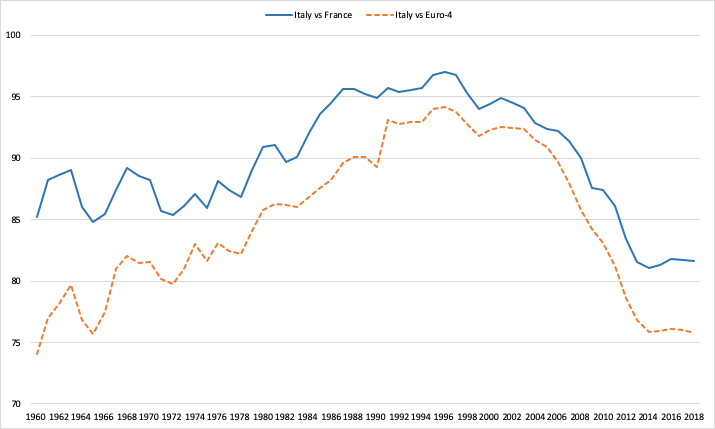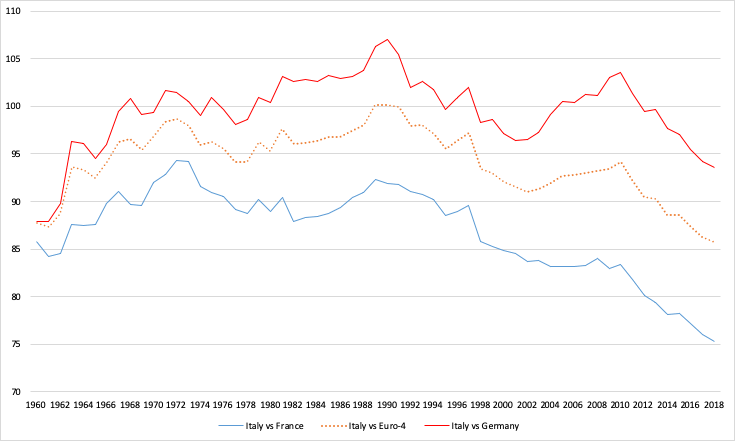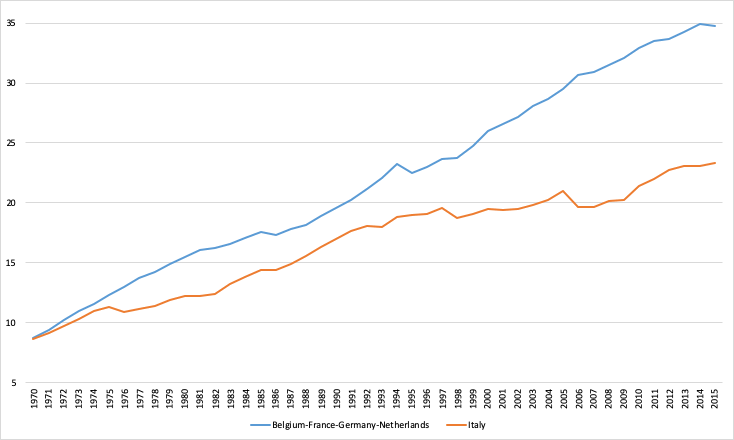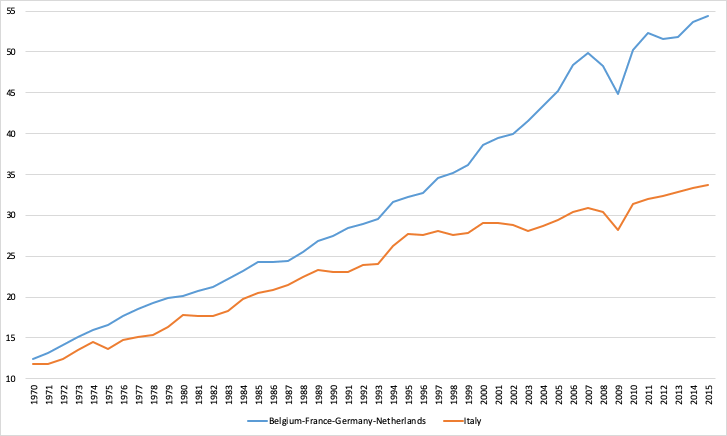Italy’s third recession in a decade
While Brexit and Trump have been making the headlines, the Italian economy has been sliding into a technical recession (again). Both the OECD and the European Central Bank (ECB) have lowered the growth forecasts for Italy to negative numbers, and in what analysts see as a precautionary move, the ECB is reviving its sovereign bond buying programme, which it had started to unwind just five months earlier.
“Don’t underestimate the impact of the Italian recession,” is what French Economy Minister Bruno Le Maire told Bloomberg News (Horobin 2019). “We talk a lot about Brexit, but we don’t talk much about an Italian recession that will have a significant impact on growth in Europe and can impact France, because it’s one of our most important trading partners.” More important than trade, however, and what Le Maire is not stating, is that French banks are holding around €385 billion of Italian debt, derivatives, credit commitments and guarantees on their balance sheets, while German banks are holding €126 billion of Italian debt (as of the third quarter of 2018, according to the Bank for International Settlements).
In light of these exposures to Italian debt, it is no wonder that Le Maire, along with the European Commission, is worried by Italy’s third recession in a decade—as well as by the growing anti-euro rhetoric and posturing of Italy’s coalition government, comprised by the Five-Star Movement (M5S) and the Lega. The knowledge that Italy is too big to fail is fuelling the audacity of Italy’s coalition government in its attempt to reclaim fiscal policy space by openly flouting the budgetary rules of the E.U.’s Economic and Monetary Union (EMU).
The result is a catch-22. The more the European Commission tries to bring the Italian government into line, the more it will feed the anti-establishment and anti-euro forces in Italy. On the other hand, the more the European Commission gives in to the demands of the Italian government, the more it will fritter away its credibility as the guardian of the EMU’s Stability and Growth Pact. This stalemate is not going away as long as Italy’s economy remains paralyzed.
A crisis of the post-Maastricht Treaty order of Italian capitalism
It is therefore vital to understand the true origins of Italy’s economic crisis in order to find pathways out of Italy’s permanent stagnation. In a new paper, I provide an evidence-based pathology of Italy’s recession—which, I argue, must be regarded as a crisis of the post-Maastricht Treaty order of Italian capitalism, as Thomas Fazi (2018) calls it. Until the early 1990s, Italy enjoyed decades of relatively robust economic growth, during which it managed to catch up with other Eurozone nations in income (per person) (Figure 1). In 1960, Italy’s per capita GDP (at constant 2010 prices) was 85% of French per capita GDP and 74% of (weighted average) per capita GDP in Belgium, France, Germany and the Netherlands (the Euro-4 economies). By the mid-1990s, Italy had almost caught up with France (Italian GDP per person equalled 97% of French per capita income) and also with the Euro-4 (Italian GDP per capita was 94% of per capita GDP in the Euro-4).
Figure 1
Three decades of catching up, 25 years of falling behind: real GDP per person in Italy relative to France/Euro-4, 1960-2018

Source: author’s calculation based on AMECO data.
But then a very steady decline began (see Figure 1), erasing decades of (income) convergence. The income gap between Italy and France is now (as of 2018) 18 percentage points, which is more than what it was in 1960; Italian GDP per capita is 76% of per capita GDP in the Euro-4 economies. Beginning in the early to mid-1990s, Italy’s economy began to stumble and then fall behind, as all major indicators—income per person, labour productivity, investment, export market shares, etc.—began a very steady decline.
It is not a coincidence that the sudden reversal of Italy’s economic fortunes occurred after Italy’s adoption of the “legal and policy superstructure” imposed by the Maastricht Treaty of 1992, which cleared the road for the establishment of the EMU in 1999 and the introduction of the common currency in 2002. Italy, as I show in the paper, has been the star pupil in the Eurozone class—the one economy that committed itself most strongly and consistently to the fiscal austerity and structural reforms that form the essence of the EMU macroeconomic rulebook (Costantini 2017, 2018). Italy kept closer to the rules than France and Germany and paid heavily for this: The permanent fiscal consolidation, the persistent wage restraint and the overvalued exchange rate killed Italian aggregate demand—and the demand shortage asphyxiated the growth of output, productivity, jobs and incomes. Italy’s stasis is an object lesson for all Eurozone economies, but—paraphrasing G.B. Shaw—as a warning, not as an example.
Perpetual fiscal austerity
Italy did more than most other Eurozone members in terms of self-imposed austerity and structural reform in order to satisfy the conditions of EMU (Halevi 2019). This is clear when comparing Italy’s fiscal policy post-1992 to that of France and Germany. Various Italian governments ran continuous primary budget surpluses (defined as public expenditure excluding interest payments on public debt, minus public revenue), averaging 3% of GDP per year during 1995-2008. French governments, in contrast, ran primary deficits of 0.1% of GDP each year on average during the same period, while German governments managed to generate a primary surplus of 0.7% on average per year during those same 14 years. Italy’s permanent primary surpluses during 1995-2008 would have reduced its public debt-to-GDP ratio by around 40 percentage points—from 117% in 1994 to 77% in 2008 (while keeping all other factors constant). But slow (nominal) growth relative to high (nominal) interest rates pushed up the debt ratio by 23 percentage points and washed away more than half of the public debt-to-GDP reductions of 40 percentage points achieved by austerity. Could it be true that Italy’s permanent austerity, intended to lower the debt ratio by running permanent primary surpluses, backfired because it slowed down economic growth?
Italy’s governments (including the left-of-centre Renzi coalition) continued to run significant primary budget surpluses (of more than 1.3% of GDP on average per year) during the crisis period of 2008-2018. Showing permanent fiscal discipline was a top priority, as Prime Minister Mario Monti admitted in a 2012 interview with CNN, even if that meant “destroying domestic demand” and pushing the economy into decline. Italy’s almost “Swabian” commitment to fiscal discipline stands in some contrast to the French (“laissez aller”) attitudes: The French government ran primary deficits at an average of 2% of GDP during 2008-2018 and allowed its public debt-to-GDP ratio to rise to almost 100% in 2018. The cumulative fiscal stimulus thus provided by the French state amounted to €461 billion (in constant 2010 prices), whereas the cumulative fiscal drain on Italian domestic demand was €227 billion. The Italian budget cuts show up in non-trivial declines in its public expenditure on social expenditure per person, which is now (as of 2018) around 70% of public social spending per capita in Germany and France. One doesn’t dare speculate what the “Gilets Jaunes” (yellow vest) protests in France would have looked like if France had put through an Italian-style fiscal consolidation post-2008.
Permanent real wage restraint
When Italy signed the Maastricht Treaty, its high rates of inflation and unemployment were regarded as major problems. Inflation was blamed on the “excessive” power of labour unions and an ”excessively” centralized wage bargaining system, which resulted in strong wage-push inflation and a profit squeeze—as wage growth tended to exceed labour productivity growth, which lowered the profit share. Seen this way, the blame for Italy’s high unemployment could be shifted onto its “rigid” labour markets and too strongly protected “worker aristocracy.” Bringing down inflation and restoring profitability required wage moderation, which in turn could only be achieved by a radical deregulation of labour markets, or what is euphemistically called, “structural reforms.”
Italy does not have a statutory minimum wage (unlike France) and also does not have a generous unemployment benefit system (in terms of unemployment insurance replacement rates and duration, and entitlement conditions) compared with the E.U. average. Employment protection for regular employees in Italy is roughly at the same level as job protection in France and Germany. Italy’s structural labour market reforms involved drastically reducing employment protection for temporary workers, and as a result, the share of temporary workers in total Italian employment increased from 10% during 1991-1993 to 18.5% in 2017. Between 1992 and 2008, total (net) employment in Italy increased by 2.4 million new jobs, of which almost three-quarters (73%) were fixed-term jobs. In France, by comparison, (net) employment grew by 3.6 million jobs during 1992-2008, of which 84% were regular (permanent) jobs and only 16% were temporary positions.
In addition, the bargaining power of unions was reduced by the abandoning of the target of full employment in favour of public debt reduction (Costantini 2017) and by a much more restrictive (anti-inflation) central bank policy and the fixed exchange rate. As a result, real wage growth per employee, which averaged 3.2% per year during 1960-1992, was lowered to a mere 0.1% per year during the period 1992-1999 and to 0.6% per annum during 1999-2008. Within the E.U., Italy’s turnaround was remarkable: From 1992 through 2008, the growth of Italian real wages per worker (0.35% per year) was only half the real wage growth in the Euro-4 (0.7% per annum) and it was even lower compared to real wage growth in France (0.9% per year). Interestingly, from 1992 through2008, Italian real wage growth per employee was slightly lower than (already stingy) German real wage growth (0.4% per year). To see the long-run picture, Figure 2 plots the ratio of the real wage of an Italian worker to the real wage of the average French, German and Euro-4 worker from 1960 through2018. In the early 1960s, the average wage of Italian workers was about 85% of the French wage, and this ratio increased to 92% in 1990-1991. Starting in 1992, the Italian real wage began a steady decline in terms of the average French wage—and in 2018, the average Italian employee earned only 75% of the wage earned by her/his French comrade. The wage gap between Italy and France is bigger today than it was in the 1960s. The same pattern holds when one compares Italian wages to German and/or Euro-4 wages.
Figure 2
Three decades of catching up, 25 years of falling behind: real wage per employee in Italy relative to France / Germany / Euro-4, 1960-2018

Source: author’s calculation based on AMECO data.
Italy’s wage moderation proved an effective strategy to kill three (not just two) birds with only one stone. First, wage restraint helped to bring down inflation—to 3.4% on average per year from 1992 through 1999 (from 9.6% on average per annum from 1960-1992) and further down to 2.5% per year from 1999 through 2008 and 1.1% from 2008 through 2018. Italy is no longer prone, in a structural sense, to high and accelerating inflation. Second, wage restraint increased the labour intensity of Italy’s GDP growth—and thus reduced unemployment. Italy’s unemployment rate peaked in the mid-1990s at more than 11%, but labour market deregulation and wage restraint successfully brought down unemployment to 6.1% in 2007 and 6.7% in 2008—which was lower than the unemployment rates of France (which equaled 8% in 2007 and 7.4% in 2008) and Germany (where unemployment was 8.5% in 2007 and 7.4% in 2008). Finally, as intended, wage moderation led to a substantial increase in the profit share of Italy’s GDP: The profit share rose by more than 5.5 percentage points, from 36% in 1991 to about 41.5% from 2000 through 2002, after which it stabilized around 40% until 2008. During the 1990s, the recovery of the profit share was considerably stronger in Italy than in France, and comparable to what happened in Germany—notwithstanding the fact that Italy’s profit share was already relatively high to begin with.
Italy’s structural reforms of the 1990s paid off handsomely in terms of a higher profit share, in other words, and Italy’s profit share remained substantially higher than that of France and Germany. With lowered inflation, effective wage restraint, declining unemployment, public indebtedness on the decline and the profit share considerably raised, Italy appeared to be set for a long period of strong growth. It did not happen. The operation was carried out successfully, but the patient died. According to the coroner’s post-mortem, the cause of death was a structural lack of aggregate demand.
The suffocation of Italian aggregate demand after 1992
By keeping close to the EMU rulebook, Italian economic policy created a chronic shortage of (domestic) demand. Domestic demand growth per Italian averaged 0.25% per year from 1992 through2018—a sharp decline compared to the domestic demand growth (of 3.3% per year) recorded from 1960 through1992 and also much below domestic demand growth (of 1.1% per person per year) in the Euro-4 countries. Italy’s real export growth (per person) also declined, from 6.6% on average per year from 1960 through 1992 to 3% per year from 1992 through 2018. Average annual export growth (per person) was 4.4% in the Euro-4 countries from 1992 through 2018. Italy’s chronic demand shortage reduced capacity utilization (especially in manufacturing) and this, in turn, lowered the profit rate. According to my estimates, capacity utilization in Italian manufacturing declined by a staggering 30 percentage points relative to capacity utilization in French manufacturing between 1992 and 2015.
The utilization rate of Italian manufacturing relative to German manufacturing declined from 110% in 1995 to 76% in 2008, and sunk further to 63% in 2015—a decline by a stunning 47 percentage points. Lower capacity utilization reduced the rate of profit in Italian manufacturing by 3 to 4 percentage points relative to French and German profit rates. This must have considerably depressed Italian manufacturing investment and growth. Let me emphasize the fact that Italy’s profit rate declined even when the share of profits in income increased. This means that Italy’s strategy of fiscal austerity and wage restraint proved to be counterproductive, because it failed to improve the profit rate: The drop in demand and capacity utilization had a bigger (negative) impact on firm profitability than the increase in the profit share.
As I argue in the paper, this condition of chronic demand shortage was created, in particular, by (a) perpetual fiscal austerity, (b) permanent real wage restraint, and (c) a lack of technological competitiveness which, in combination with an unfavourable (euro) exchange rate, reduces the ability of Italian firms to maintain their export market shares in the face of increasing competition of low-wage countries (China in particular). These three factors are depressing demand; reducing capacity utilization and lowering firm profitability; and hurting investment, innovation, and productivity growth. They are hence locking the country into a state of permanent decline, characterized by the impoverishment of the productive matrix of the Italian economy and the quality composition of its trade flows (Simonazzi et al. 2013).
Italy’s manufacturing sector is not “technology intensive” and suffers from stagnating productivity. As Figures 3 and 4 illustrate, the cost competitiveness of Italian manufacturers vis-à-vis the Euro-4 countries depends on low wages and not on superior productivity performance. Whereas industrial workers in France and Germany were earning €35 per hour (in constant 2010 prices) in 2015, and their colleagues in Belgium and the Netherlands earned even more, Italian workers in manufacturing were bringing home only €23 per hour (in constant 2010 prices)—or one-third less (see Figure 3). But at the same time, industrial labour productivity per hour of work is considerably higher in France and Germany (at €53 per hour in constant 2010 prices) than in Italy, where it is around €33 per hour (Figure 4). Italian manufacturers are thus taking the low road, while firms in the Euro-4 countries are travelling on the high road. Or in other words, compared with German and French manufacturers, Italian firms suffer from a lack of technological strength, which in Germany is based on high productivity, innovative efforts and high product quality. True, Italian firms do stand out for their high relative quality in more traditional, lower-tech export products such as footwear, textiles, and other non-metallic mineral products. But they have been steadily losing ground in export markets of more dynamic products characterized by higher levels of R&D and technology intensity, such as chemicals, pharmaceuticals and communications equipment (Bugamelli et al. 2018).
Locked into a position of structural weakness
For two reasons, this specialization in low- and low-medium technology activities locks the country into a quasi-permanent position of structural weakness. The first is that the exchange-rate elasticity of export demand is larger for traditional exports than for medium- and high-tech exports. As a result, the appreciation of the euro did hurt Italian exporters of traditional products harder than German and French firms exporting more “dynamic” goods and services. Thus, the overvalued euro penalizes Italian export growth more than it damages export growth in the Euro-4 economies.
The second factor is that Italian firms are operating in global markets which are more strongly exposed to the growing competition of low-wage countries and China in particular. In 1999, 67% of Italy’s exports consisted of (traditional) products exposed to medium to high competition from Chinese firms—compared to a similar exposure to Chinese competition of 45% of exports in France and 50% of exports in Germany (Bugamelli et al. 2018). The share of Italy’s exports in world imports declined from 4.5% in 1999 to 2.9% in 2016—and the market share loss was heavily concentrated in more traditional market segments characterized by high exposure to Chinese competition (Bugamelli et al. 2018). As Chinese and other developing economy firms continue to expand their production capabilities and to upscale, competitive pressures will mount in medium- and medium-high tech segments as well. Italian firms have difficulties facing competition from low-wage countries: They are generally too small to wield any pricing power, too often single-product producers unable to diversify market risks, and too dependent on foreign markets, because their home market is in the doldrums.
Figure 3
Real wage per hour of work in manufacturing: Italy versus the Euro-4 countries, 1970-2015 (euro’s, constant 2010 prices)

Source: author’s calculation based on EU-KLEMS (Jäger 2017).
Figure 4
Manufacturing labour productivity per hour of work: Italy versus the Euro-4 countries, 1970-2015 (euro’s, constant 2010 prices)

Source: author’s calculation based on EU-KLEMS (Jäger 2017).
Italy’s permanent crisis is a warning for the Eurozone
There are rational ways to get the Italian economy out of the current paralysis—none of them easy, and all of them founded on a long-term strategy of “walking on two legs”: (a) reviving domestic (and export) demand, and (b) diversifying and upgrading the productive structure and innovative capabilities and strengthening the technological competitiveness of Italy’s exports (to get away from direct wage-cost competition with China). This means that both austerity and real wage growth suppression must stop. Instead, the Italian government should gear up for providing unambiguous directional thrust to the economy by means of higher public investment (in public infrastructure and “greening” and decarbonizing energy and transportation systems) and novel industrial policies to promote innovation, entrepreneurship and stronger technological competitiveness.
There is no dearth of constructive proposals by Italian economists to help their economy out of the current mess—including Guarascio and Simonazzi (2016), Lucchese et al. (2016), Pianta et al. (2016), Mazzucato (2013), Dosi (2016), and Celi et al. (2018). These proposals all centre on creating a self-reinforcing process of investment-led and innovation-driven growth, orchestrated by an “entrepreneurial state” and founded on relatively regulated and co-ordinated firm-worker relationships, rather than on deregulated labour markets and hyper-flexible employment relations. These proposals might work well.
The same cannot be said, however, of the “one-leg” fiscal stimulus proposed by the M5S-Lega coalition government, the aim of which is a short-run revival of domestic demand by means of higher public (consumption) spending. None of the proposed spending will help solving Italy’s structural problems. What is completely lacking is any longer-term directional thrust, or the second leg of a viable strategy—which the neoliberal Lega will be unwilling to provide and the “progressive-in-name-only” M5S seems incapable of devising (Fazio 2018). Plus ça change, plus c’est la même chose.
More importantly, any rational “two-leg” developmental strategy will be incompatible with sticking to the EMU macroeconomic rulebook and keeping financial markets calm, which are supposed to act as the disciplinarian of Eurozone sovereigns (Costantini 2018; Halevi 2019). This is clear from what happened when the M5S-Lega government came up with an expansionary Draft Budgetary Plan (DBP) for 2019. The total impact of the one-leg fiscal stimulus initially proposed in the 2019 DBP amounted to an estimated 1.2% of GDP in 2019, 1.4% in 2020 and 1.3% in 2021—and even this minute budgetary expansion triggered strong negative responses from the European Commission and increases in Italian bond yields.
Blanchard et al. (2018, p. 2) formalize this status quo in a mechanical debt-dynamics model and conclude that the 2019 DBP risks triggering “unmanageable spreads and serious crisis, including involuntary exit from the Eurozone.” Blanchard et al. (2018, p. 16) argue for a fiscally neutral budget, which they think would lead to lower interest rates and “probably” (in their words) to higher growth and employment. Equations, graphs and technocratic econospeak are competently used to turn what in fact constitutes a very modest transgression of the EMU rulebook into a low-probability- catastrophic event—which everyone would want to avoid (see Costantini 2018). What is tragic is that the 2019 DBP does not come close to what would be needed for a rational strategy. All the sound and fury is for nothing.
Worse still is the fact that maintaining Italy’s status quo, which is what a fiscally neutral budget would mean, carries a real, but unrecognized low-probability, high-impact risk: a breakdown of political and social stability in the country. Continued stagnation will feed the resentment and anti-establishment, anti-euro forces in Italy. This will destabilize not just Italy, but the entire Eurozone. Italy’s crisis thus constitutes a warning to the Eurozone as a whole: Continued austerity and real wage restraint, in combination with the de-democratization of macroeconomic policymaking, make for a “dangerous game” (Costantini 2018)—a game which risks further empowering anti-establishment forces elsewhere in the Eurozone as well.
This is like opening Pandora’s box. No one can tell where this will end. Economists (including Italians) carry an enormous responsibility in all this, both because they are much to blame for the chaos and because they fail to continue to unite behind rational strategic solutions to resolve the Italian crisis. “Perhaps,” John Maynard Keynes wrote, “it is historically true that no order of society ever perishes save by its own hand” (Keynes 1919). Rational economists have to prove Keynes’ verdict wrong, starting in Italy—if only because the Brexit mess appears to be beyond redemption.
References
- Blanchard, O., Á. Leandro, S. Merler and J. Zettelmeyer. 2018. “Impact of Italy’s draft budget on growth and fiscal solvency.” Policy Brief 18-24. Washington, D.C.: Peterson Institute for International Economics.
- Bugamelli, M., S. Fabiani, S. Federico, A. Felettigh, C. Giordano and A. Linarello. 2018. “Back on track? A micro-macro narrative of Italian exports.” Ministry of Economy and Finance Working Paper No. 1. Rome: Ministry of Economy and Finance.
- Celi, G., A. Ginzburg, D. Guarascio and A. Simonazzi. 2018. Crisis in the European Monetary Union: A Core-Periphery Perspective. London: Routledge.
- Costantini, O. 2017. “Political economy of the Stability and Growth Pact.” European Journal of Economics and Economic Policy: Intervention 14 (3): 333-350.
- Costantini, O. 2018. “Italy holds a mirror to a broken Europe.” Blog post, Institute for New Economic Thinking, June 14.
- Dosi, G. 2016. “Beyond the ‘magic’ of the market. The slow return of industrial policy (but not yet in Italy).” Economia e Politica Industriale 43 (3): 261-264.
- Fazi, Th. 2018. “Italy’s organic crisis.” American Affairs Journal, May 20.
- Halevi, J. 2019. “From the EMS to the EMU and …. to China.” INET Working Paper. Forthcoming.
- Horobin, W. 2019. “Le Maire Says Italian Recession Threatens France’s Economy.” February 20, Bloomberg.com.
- Jäger, K. 2017. EU KLEMS Growth and Productivity Accounts 2017 Release. Description of Methodology and General Notes. New York: The Conference Board.
- Keynes, J.M. 1919. The Economic Consequences of the Peace. New York: Harcourt, Brace and Howe.
- Lucchese, M., L. Nascia and M. Pianta. 2016. ‘Industrial policy and technology in Italy.’ Economia e Politica Industriale 43 (3): 4-31.
- Mazzucato, M. 2013. The Entrepreneurial State: Debunking Public vs. Private Sector Myths. London: Anthem.
- Monti, M. 2012. “Transcript of an interview with Fareed Zakaria of CNN.”
- Paternesi Meloni, W. and A. Stirati. 2018. “Macroeconomics and the Italian vote.” Blog post, Institute for New Economic Thinking, August 6.
- Pianta, M., M. Lucchese and L. Nascia. 2016. What is to Be Produced? The Making of a New Industrial Policy in Europe. Brussels: Rosa Luxemburg Stiftung.
- Simonazzi, A. , A. Ginzburg and G. Nocella. 2013. ‘Economic relations between Germany and southern Europe.’ Cambridge Journal of Economics 37 (3): 653–675.






